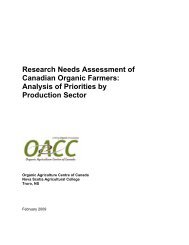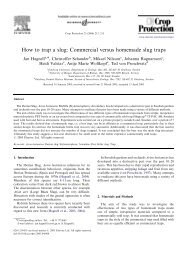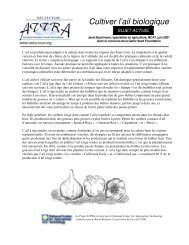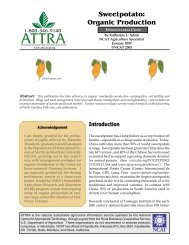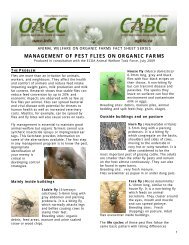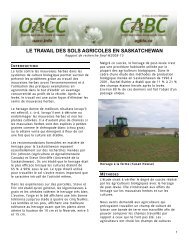You also want an ePaper? Increase the reach of your titles
YUMPU automatically turns print PDFs into web optimized ePapers that Google loves.
grown too late in the spring, cover cropscan draw moisture down from the soil’supper layer, where it will be needed <strong>for</strong> seedgermination and stand establishment ofsubsequent cash crops.Thus, knowing when to kill and incorporatecover crops in the spring is abalancing act. The goal is to produce thegreatest possible amount of biomass, orliving matter, with the cover crop, whichmaximizes fertilizer values, while notdepleting soil moisture. Timing is everything.In early spring, while cover crops are stillactively growing, farmers should beginmonitoring soil moisture. During yearswith normal to dry weather patterns, thebest time to kill cover crops is usually twoweeks be<strong>for</strong>e planting cash crops(depending on weather <strong>for</strong>ecasts). Biomassyield and nitrogen (N) production bylegume cover crops may not be at theirmaximum levels at this point. However, inmost seasons, sufficient rainfall <strong>for</strong> adequatecrop emergence will occur during thetwo-week preplant period or within theweek immediately following planting. Inwet years or when a rainy period is <strong>for</strong>ecast,the cover crop can be killed immediatelybe<strong>for</strong>e soil preparation and planting ofspring crops.With these weather windows in mind, afarmer can create a plan to produce thehighest possible cover crop biomass andbiomass N yields. Studies show that whencover crop kill is delayed from early April toearly May, the yields of hairy vetch, cerealrye, and mixtures of both increase by anaverage of 160 percent in the Marylandpiedmont and by 83 percent in the coastalplain (Clark et al., 1994). In Clark’s study,the N contents of hairy vetch and hairyvetch-rye mixtures were 1.6 to 2 timesgreater at the late kill date: They rangedfrom 65 to 100 pounds N per acre <strong>for</strong> earlykill, and from 135 to 200 pounds N per acre<strong>for</strong> late kill. Based on those considerationsand by monitoring soil moisture and obtainingrainfall predictions, a farmer candecide on the best possible times <strong>for</strong> killingand incorporating a cover crop.Weed Management<strong>Cover</strong> crops and surface crop residues canbe used to control or inhibit weeds insubsequent cash crops in three basic ways:• By smothering and shading them sothey don’t receive adequate air andlight.• By outcompeting them <strong>for</strong> nutrients.• By producing an effect known asallelopathy, the toxic effect on weed seedgermination and seedling growth thatoccurs as residues of some cover cropsdecompose.The primary way to suppress weed seedgermination and growth is to have avigorous cover crop stand. Such a stand willsimply out-compete weed seeds <strong>for</strong> lightand nutrients (Teasdale and Daughtry,1993). When the cover crop is killed, itsthick residues remain on the surface andhinder weed growth by physicallymodifying the amount of natural light, soiltemperature, and soil moisture that isnecessary <strong>for</strong> weed seed germination.It’s important to note that suppressingweeds by smothering them becomes lesseffective as cover crop residues decompose.How fast residues decompose depends onseveral variables. For instance, warmtemperatures, rainfall, and field tillage canspeed up the decomposition rate. Anotherimportant factor is the C:N ratio, thecarbon-to-nitrogen ratio of different kindsof crop residues. Residues with a high C:Nratio, such as mature small grain cover<strong>Organic</strong> Production—<strong>Cover</strong> <strong>Crops</strong> <strong>for</strong> <strong>Organic</strong> <strong>Farms</strong> 3



